Mike
Lyon visits BarenForum founder, David Bull

Crowds near Asakusa Shrine, Tokyo.
My
Mom, my Dad, my sister and I planned our first "nuclear
family" vacation in 35 years. Tokyo, Hakone, Kyoto, and
Amanohashidate. Twelve days. WOW! What a great trip this was!
While my Mom and sister had a free day of their own in Kamakura,
Dad and I spent our second day in Japan, April 20, 2003, visiting
David Bull.
We
were staying at the Imperial Hotel in central Tokyo. Dad and
I took the train from Tokyo station West to Ome City, where
David lives. The trains themselves were an exciting adventure
even though Dave had given good directions. I neither read
nor speak Japanese which was something of a hindrance to efficient
travel. For example, when we got to the train station there
didn't appear to be any way to purchase a ticket. No information
desk. Nothing but fancy pay phones and a long row of automated
entrance gates. So, after studying the situation for a minute
I noticed that some of the gates appeared to be locked open.
I just walked through. The gates are highly automated and
remain open so that ticketed passengers can move through quickly.
But they are rigged to snap shut if you go through without
sliding your ticket into the slot. When the gates closed (and
I tripped over them) and the alarm bells rang, I immediately
saw there was a guard stationed nearby (to catch foolish gaijin
illiterates like me). He waved me over and I used my 50 words
of Japanese to explain that we wanted to go to Ome. He calculated
the price of a ticket to Ome and showed me the amount on the
screen of his calculator (I think he'd done this before) and
then pointed me back to the fancy pay phone in the entry which
turned out to NOT be a pay phone, but rather an incomprehensible
ticket machine of some sort, with destinations and instructions
all neatly and electronically displayed… in Japanese.
I couldn't make heads nor tails of ANY of it, of course. With
a sigh, the guard helped me pay for two tickets to Ome city
and we were off! Later David Bull demonstrated how to push
the "English" button on the Ome version of the same
machine which miraculously translated all the text into…
English!! But I overlooked that feature the first time.
Eventually
we managed to change to the Ome train at the right station
and 90 minutes after we departed Tokyo, we arrived in Ome,
a very beautiful suburb of Tokyo nestled up against the mountains
right at the Western periphery of the city. What a charming
and very beautiful town! I handed David's address to the Taxi
driver outside the train station, but he didn't seem to have
a clue where we wanted to go. Dave's phone number was there
along with the address, so the driver called Dave, got directions
and five minutes later we pulled up to David Bull standing
next to his house awaiting our arrival! My Dad and I felt
very accomplished to have so successfully navigated all the
way!
When
I stepped out of the cab and said "hey!" and shook
David's hand, his first words were something like, 'gee…
you are not at all what I expected! Your voice is much softer
than I expected! I imagined you'd be loud and somehow more
gruff! You're not at all the fit and macho guy I imagined!'
For
my part, I had in mind the image of a man 5'4" or 5'5"
David Bull. Tiny and bird-like and precise with limitless
energy. But Dave is more hawkish than bird-like and much taller
than I'd imagined – nearly six feet, I'd guess. Precise
and limitless energy do hit pretty near the mark, though.
Dave seems to be a very straight forward, opinionated (in
a good way) and outspoken guy. A dynamic no B.S. sort. Seldom
wrong, never uncertain.
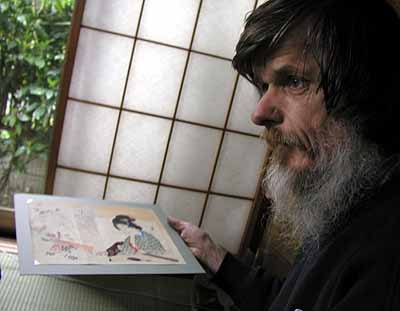
Dave shows off a late 19th century woodblock
printed magazine insert from his collection.
Dave's
smart. Very smart. Very well and very widely read. Mostly
self-educated. Huge library. Huge! The books on wood block
printmaking alone occupy about eight feet of bookshelf. I
didn't have a clue there were so many books written on the
subject and hadn't heard of most of the titles. And he's focused.
Doesn't waste much time on stuff which doesn't move him toward
his goal of becoming a better printmaker. Not that he isn't
already a good printmaker. Over here we'd label him a "master
printer". Which he denies, of course. I think Dave views
himself as an intermediate printmaker. He compares himself
to the old printers he's met and he falls short in his own
estimation. But there's no question in my mind that he fits
the "master" mold. With more than 20 year's experience
as a moku-hanga printmaker, he's certainly put in the time.
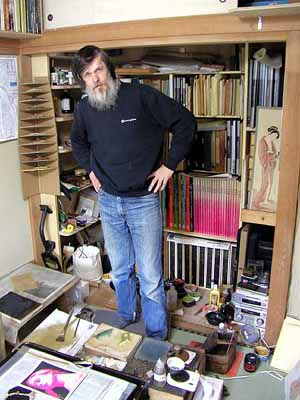
David and his printing area. Baren collection
to his right.
David
made us coffee and showed us the ground floor of his home
on the mountainside. It's tiny by US standards. Tiny kitchen,
a half-bath near the front door – actually half bath
is incorrect. It's a room just large enough to houlse a toilet.
But the top of the tank is concave with a drain hole in the
bottom and a chrome plated water spigot which extends up through
the drain hole and then curves back down. So when you flush,
the tank is refilled from the spigot with the tank lid doubling
as a small wash basin. Very efficient! There's another bathroom
off the kitchen, and the large bath inside provides the only
winter-time heat (other than a 500 watt light bulb). Before
bed, while chilled through from working all day in the zero-degree
house, Dave warms the bath and climbs in to soak. Then races
into the futon before he cools down again! Ascetic? You bet!
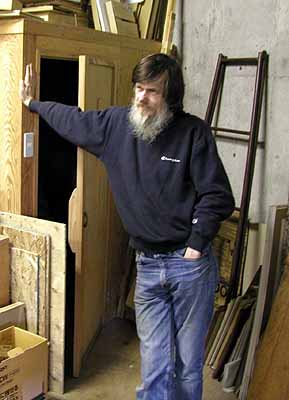
Downstairs. Blocks from prior prints stored
in cabinet behind.
There
really is something monk-like about this guy. He lives frugally
and mostly alone, I think (girlfriend Sadako has her own home
and her own interests). He tries to waste nothing. Wood scraps
from his on-going home improvement project are stacked for
later re-cycling. Newspapers, lumber, scraps too small for
blocks, etc. etc. are neatly stacked in his downstairs storage
room. There's no unnecessary heat, light, water, wood, paste,
pigment, paper, etc. Dave saves his money to buy the best
pigments and paper and tools he can find. He's received several
gifts from the families of deceased craftsmen. He carefully
keeps the slab bench given to him from the widow of a man
who specialized in smoothing planks with a plane. He uses
a knife passed down to him by the family of an old master
carver. He treats these tools with the greatest reverence
and respect. As a printer he's completely uncompromising.
David
and my Dad talked together for a good hour or so after we
arrived. About glass casting. About good books. About politics
and the economy. David described his many years-long printing
of the works designed by other artists, mostly long-dead.
Every ten or fifteen minutes our conversation was interrupted
by the blaring of a van-mounted loudspeaker. Elections were
coming up soon. Two weeks before the elections, the candidates
campaign non-stop. Driving through town announcing all the
good things they will do once elected. I couldn't understand
a word, of course, but it was LOUD for sure!
Dave
showed off some of the prints from his surimono albums. And
my Dad said, "Just one thing about all this would drive
me up the wall… I mean, don't you ever have the desire
to design your own…" And without hesitation, Dave
fairly leapt across his small printing table (where he'd been
sitting and quietly printing a beautiful copper metal powder
onto his current surimono) and thrusting out his index finger
as if to impale my poor father he almost shouted, "Hey
now! Don't YOU start up with me, too!"… My 78 year
old Dad was so surprised! He paused in mid-sentence, fish-faced.
His eyes wide open, his mouth opened and closed, he started
to speak several times but nothing came out. David leaning
into a strong wind, arm extended, finger pointed, so intense.
It was quite a moment. And I collapsed laughing. And we talked
about it. Design and process. Creativity and craftsmanship.
The honing of one's skill.
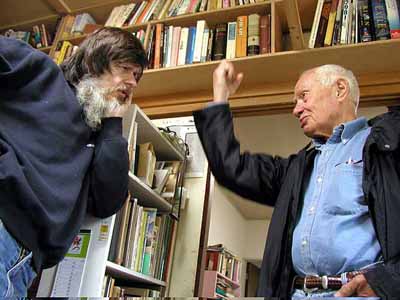
Dave and my dad. That book case Dave leans
on is exclusively books on woodblock printmaking!
I'd
brought a bunch of my prints with me to show and get Dave's
input which went something like, "Too wet, maybe. Too
dry, perhaps. Wrong paper -- nobody could make a decent print
on that stuff! Not enough pressure. You didn't carve far enough
around your printing areas. Etc." If this sounds like
Dave was being critical, nothing could be further from the
truth! He was gentle and supportive and his comments always
constructive. It was great! Dave demonstrated how he squeezes
the 'handle' of his baren to increase its convexity and so
put extra pressure on a very small area. We looked at the
braided cord of an old and very great baren. I learned that
the cord must be placed into its cover in exactly the spot
it came from in order to maintain its 'broken-in' feel. Each
time the cord is rotated or flipped over, a whole new set
of 'high spots' contact the paper and these must be pressed
back down over time to break it in again. Eventually, the
cord loses its strength in printing (no more bumps in the
braid) and must be replaced.
Dave
showed me an excellent baren which had been re-covered by
the Kikuhide Workshop (top-notch). The bamboo sheath itself
was much thinner and finer than any I have received here in
Kansas City, and the sheath was tied on extremely smoothly
and well. It was a thing of incredible beauty and utility.
While
we watched, Dave showed us how he applies copper powder to
an area of his current surimono. The paper to be printed is
in a damp newsprint stack on a low table in front of him (he
prints sitting cross-legged in his "library") and
printed sheets go into a similar damp stack to his right.
Dave has some dilute hide glue in a bottle on a coffee mug
warmer. He applies a bit to a white-glazed ceramic tile reserved
for the purpose and he uses a baren-diameter leather "tamper"
with a knob attached to pick up some of the glue, and then
dampen his block. The tamper is used in place of a brush,
as the block is covered in copper powder which would quickly
gum up any brush. Then the glue is lightly printed onto the
paper. Copper powder is 'spooned' onto the block with a long
bamboo tea scoop. The powder is lightly brushed across the
still-damp block and then the block is tapped over the pile
of copper powder to recycle the excess. Then the paper is
re-printed and when the paper is pulled from the block, a
beautiful and extremely even copper (looks like copper leaf)
has been applied.
"Careful
now. Watch out!" Dave calls out to my Dad each time he
prints. When I finally ask why he keeps saying that, he explains
about health hazards associated with the metallic powders.
Not that Dave is overly concerned about breathing the fine
copper dust, but he takes a few simple precautions to minimize
the amount he breathes in. A small fan -- the kind you'd cool
a room with on a hot day -- is set against a low window and
it blows outward. The suction side has cardboard taped to
it to form an intake duct between the two damp stack tables.
Dave's pile of copper dust sits right in front of the cardboard
ductwork, so most airborne particles are exhausted outside.
Simple and effective.
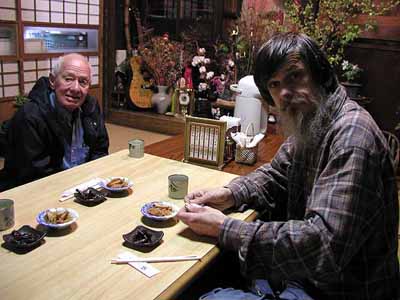
Dad and Dave enjoy some pickles and tea before
lunch.
It's
time for lunch. There's a noodle shop just across the street
uphill from Dave's home. The proprietor/chef and his wife
live there, I believe, but one side of the house is for guests.
You enter through a typical shoji sliding door to find two
low tables on the right and two on the left side of a relatively
large tatami-matted room which is literally packed full of
stuff. Live plants, dried plants, dried flowers, lanterns,
beads, paintings, a guitar, posters, wreaths, baskets, photos,
calligraphy, trees, ropes… Very charming and very alive!
The menu is noodle soup. Noodle soup with pork (delicious).
Noodle soup with egg. Noodle soup with beef. Noodle soup with
seafood. The noodles are homemade as is everything else. This
little neighborhood hangout was a highlight of our trip. Dave
told us that the owner wasn't too happy to see him move in,
as the guy who used to live in Dave's house was "quite
the drinker" and the restaurant is a favorite haunt of
the neighborhood men. Nightly drinking and socializing and
drinking. Dave's not much into that. But it sure seemed to
me that everyone got along famously in spite of Dave's relative
temperance.

Dave and me after lunch. Dave left half his
broth, I ate it all! You can tell by my more satified expression...
After
Dave paid for our lunch (thank you so much, Dave, it was delicious!),
we walked back over to the house and talked quite a while,
then took a tour of the lower floors of Dave's house. His
framed in future studio. His gorgeous view. His workshop/storage
room. Some keepsakes. Maybe someday he'll buy the property
next door. It's a small parking area adjacent to the road
supported forty feet above the streambed by a metal framework
of somewhat questionable durability. Maybe shoot a low and
long dormitory through the scaffolding in order to house those
who wish to become disciples – to visit and spend months
or years practicing their carving and printing. But not in
the house. Too disruptive. Takes time away from the object
of everything: Printmaking. Let them be close, just not too
close. Well, that's a dream of the future.
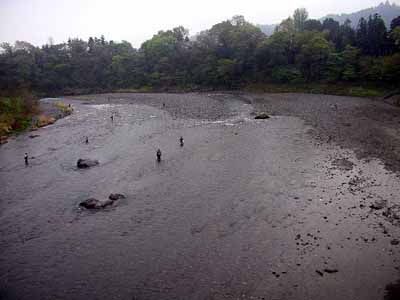
Fishermen in river near Dave's home in Ome.
Dave
walked us back to the train station. A 15 minute hike through
the neighborhood and down the mountain side, along a path
and over a large bridge. It was Sunday, and there were lots
of picnickers on the river bank and lots of fishermen wading
and casting in the river. Gorgeous area! Then up the other
embankment climbing through town on the other side of the
river. "This guy's a politician. This guy is an amateur
horticulturalist. The order of the candidates on the election
billboards is determined by lottery." All the Ome gossip.
Then suddenly we'd arrived back at the train station. And
after chastising us for having bought a one-way ticket instead
of the less-expensive weekend pass, or better yet, since we
were heading for Kyoto, a week-long rail pass, Dave showed
us the button on the ticket vending machine which converted
everything to English! And we were off! Great visit, great
host, great guy, great printmaker!

Almost time to say good-bye...
Thanks
so much for your generous hospitality, Dave!
--
Mike Lyon, April 2003